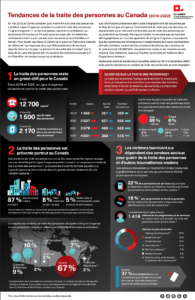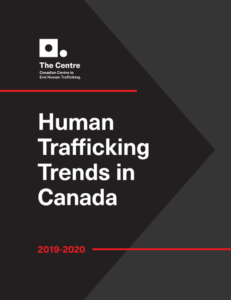La Ligne d’urgence canadienne contre la traite des personnes publiera des données anonymes provenant de sources variées tel que: des appels reçus et des signalements en ligne, des fournisseurs de services ainsi que des organismes d’application de la loi, partout au Canada. Les données recueillies et publiées par la Ligne d’urgence aident à porter assistance aux victimes et aux survivants, à fournir des informations permettant de lutter contre toutes les formes de traite au secteur de la lutte contre la traite des personnes et d’éduquer les Canadiens sur le trafic qui se déroule dans leur communauté.
Les tendances de la traite des personnes au Canada (2019-2022)
La Ligne d’urgence canadienne contre la traite des personnes a identifiée 1 500 cas de traite de personnes depuis son lancement en mai 2019. Les données récemment publiées montrent que le nombre de cas a fluctué entre 251 et 460 cas par an. Pendant cette période, la Ligne d’urgence a soutenu 2 170 victimes et survivant.e.s de la traite des personnes. Les victimes/survivant.e.s constituaient le principal groupe d’appelants – environ 37 % – qui se sont adressés au service confidentiel et centré sur la personne de la Ligne d’urgence.
Bien que le Centre ne recueille pas de données démographiques sur tous les appelants de la Ligne d’urgence, nous savons que les communautés historiquement marginalisées sont sous-représentées dans les données, notamment les peuples Autochtones, les membres de la communauté 2SLGBTQIA+, les personnes noires et racialisées ainsi que les travailleur/euses migrants/es. Nos données sont uniquement basées sur les informations fournies volontairement par les appelants.
La traite des personnes : les tendances au Canada (2019-2020)
Les données recueillies au cours de la première année de fonctionnement de la Ligne d’urgence canadienne contre la traite des personnes indiquent que la traite des personnes à des fins d’exploitation sexuelle est un crime fondé sur le genre qui touche d’abord et avant tout les femmes et les filles canadiennes.
Le rapport “La traite des personnes : les tendances au Canada (2019-2020)”, publié par le Centre canadien pour mettre fin à la traite des personnes, révèle également que les hommes et les femmes transgenres ainsi que les personnes non-conformes à un genre sont victimes de la traite de manière disproportionnée par rapport à leur pourcentage démographique. Bien qu’il forme 0,24 % de la population canadienne, ce groupe représente 2 % de l’ensemble des victimes/survivants qui téléphonent à la Ligne d’urgence.
Pour la première fois au Canada, le rapport du Centre est une publication qui ne se fonde pas sur les statistiques fournies par les corps policiers. Le Centre a plutôt utilisé les données anonymes recueillies par la Ligne d’urgence canadienne contre la traite des personnes pour cerner six grandes tendances en matière de traite des personnes au Canada




